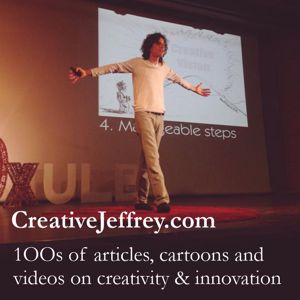Report 103
Your newsletter on applied creativity, imagination, ideas and innovation in business.
Tuesday, 5 January 2010
Issue 162
Hello and welcome to another issue of Report 103, your fortnightly newsletter on creativity, imagination, ideas and innovation in business.
As always, if you have news about creativity, imagination, ideas, or innovation please feel free to forward it to me for potential inclusion in Report103. Your comments and feedback are also always welcome.
Information on unsubscribing, archives, reprinting articles, etc can be found at the end of this newsletter.
DO YOU TRUST YOUR COMPANY?
The innovation process, described in glorious detail elsewhere in this issue of Report 103, requires considerable amounts of trust. Without it, the process is unlikely to produce much more than incremental innovation. Worse, great ideas devised by employees are likely to be taken elsewhere for implementation. Indeed, in an innovation survey published by PWC in the early 2000s, trust was identified as a key characteristic of innovative companies. It is not hard to see why.
The innovation process involves risk both for the firm running the process and employees participating in the process. The firm must invest resources in the process and it must be willing to implement creative ideas which have the potential to become innovations (remember, an idea is not innovative until it has been successfully implemented). Creative ideas are inherently more risky than incremental improvement ideas. Unless the firm is willing to take on this risk, it's innovation investment will bring only incremental results.
Personal Risks
Employees also take risks by participating in the innovation process. Depending on the company, they might face ridicule, reprimand, lost promotional opportunities and dismissal. Or, they might look forward to recognition, responsibility and improved promotion prospects. It goes without saying that if employees can look forward to the latter set of actions, they are more likely to participate. For this to happen, they need to trust their colleagues, management and company.
Risk rears its ugly head during several parts of the innovation process. The company needs to ensure that risk is minimised through trust. Let's see how it works.
Identifying Problems
Although many people believe organisational innovation starts with ideas, it actually starts with identifying problems and goals. Finding fault in well established processes is easy. Communicating it to superiors who may have a stake in that process is challenging. People who criticise corporate processes may well be branded trouble-makers, rebels or worse. Unless a firm openly invites people to question assumptions and established processes, most employees will keep criticism to themselves or, at best, share it at the coffee machine with colleagues of equal standing.
While many firms may claim that they are open to the questioning of assumptions and criticism of processes, the employee must trust the firm that it is being open and honest. Without that trust, criticism will not be shared.
Idea Generation
Albert Einstein is credited with saying: “If at first the idea is not absurd, then there is no hope for it.” This is true, great ideas almost always seem absurd at first. Unfortunately, so do absurd ideas!
For many people, being absurd in front of their colleagues and, especially, their superiors, is a scary thing. Unless, they trust superiors and other colleagues to take all ideas seriously rather than laugh, criticise or worse, most people will keep their more absurd (and hence creative) ideas to themselves.
In many organisations, the person who suggests lots of absurd ideas may quickly be branded as a clown. And while clowns are jolly good fun at the pub, they are probably not on the fast track for management. In other words, without trust, the more creative ideas are not shared. They are suppressed. And with sufficient suppression of creative ideas, most people learn to be less creative at work. And without creativity, innovation simply will not happen.
In a trustworthy organisation, on the other hand, crazy ideas are embraced and the people who propose them most often are recognised as creative thinkers – not clowns.
Championing Crazy Ideas
In many firms, managers, who champion ideas that are rejected as non-viable, are branded as losers. Intelligent, creative managers learn this quickly. They also learn to champion the least risky, least creative ideas rather than risk acquiring the loser label. As a result, the most creative ideas are ignored in favour of mediocre ideas that are sure not to fail, even if their success potential is limted.
Of course trustworthy top management does not brand subordinates as losers under any circumstances. Quite the opposite. They respect managers who see potential in creative ideas and are willing to take risks by championing them.
High Risk Projects
The greatest level of personal risk an employee in most firms can take on is managing a potentially innovative project. As noted, such projects are very risky. If they succeed they can result in huge benefits, usually in the form of increased profits, improved position in the market and recognition as being a leading firm. If the potentially innovative project fails, on the other hand, money will have been lost, resources wasted and the people responsible fired – or at least passed over for promotion for a few years.
Oops! Of course that last bit, about being fired or passed over for promotion, should not be the consequences of managing a potentially innovative project, should it? But you and I both know it very often is the case.
If a company's best people know that leading a failed project – or even being on the team – is dangerous to their career, they will quickly learn to avoid risky, potentially innovative projects like the plague. Needless-to-say, if people avoid projects that have the greatest innovation potential, those projects are unlikely to ever come to fruition.
Managers in trustworthy companies, on the other hand, know not only that they can take risks by managing innovative projects, but that they will be rewarded for doing so. They also know that if the project does not succeed, they will not be reprimanded. Rather, they will be expected to drop the project quickly, share what they have learned and take on a new project.
This has two benefits. Firstly, managers will be keen to take on potentially innovative projects without fear of unpleasant consequences. Secondly, if a project is not succeeding, they will not be afraid to drop it and focus on something else. In companies where failed projects lead to failed careers, manager are highly reluctant to drop a project and admit failure. Instead, they tend to throw more resources into the project and hope it improves. As a result, failed projects are even more costly in financial terms. In other words, the company and the responsible manager lose when failure is not an option!
Making Your Firm More Trustworthy
The lessons to be learned here, if you want to make your firm more trustworthy, are simple:
-
People should not be criticised for identifying problems and weaknesses with existing processes. They should be listened to and rewarded.
-
People should not be criticised for having outlandish ideas. Rather, those ideas should be evaluated as they may have tremendous innovation potential. If the ideas are not viable, explain why and complement the person or team who has proposed them. Never criticise the people for being creative, even if their ideas do not work.
-
Managers who champion radical ideas and take on risky projects should be recognised as your top people and critical to your innovation process. They should never be reprimanded for failed projects without good reason (such as fraud, making the same mistake over and over again, committing a crime and similar actions which are morally, ethically or legally unacceptable).
How about your firm? How trustworthy is it? I'd love to hear your thoughts – in complete confidentiality of course!
BACK TO INNOVATION BASICS
If you are a regular reader of Report103, you will know that we are writing a serious of articles on the basic terminology and processes associated with innovation. Following an informal survey some weeks ago, we have found that there is a lack of clarity with respect to the basic terms used in innovation – there is even disagreement on the definition of the very word itself! Hence, I've made the rather audacious move to run in Report 103 a series of articles covering basic terms and processes associated with innovation. If you missed the introduction to this series of articles or would like to read it again, you can do so at http://www.creativejeffrey.com/creative/innovation_basics.php And if you disagree with what I've written, let me know!

THE INNOVATION PROCESS
The innovation process, at least for businesses, is a relatively simple one that starts with a business problem and ends with the implementation of creative ideas in order to generate value, usually in the form of reduced operational costs, increased income or, ideally, both.
Two Delusions about Innovation
There are two common delusions about the innovation process. One is that it is very easy. All a company has to do is build or buy an electronic suggestion box (often called "suggestion scheme software" and sometimes incorrectly called "idea management software") to collect ideas and suddenly, the company will be innovative. Not surprisingly, it is mostly vendors of said suggestion scheme software products who champion this approach. But the truth is, ideas are, well, just ideas. If they are not implemented, or even properly identified as potential innovations, they generate no value. Indeed, in my experience, suggestion schemes die after 12-18 months.
The other common delusion is that the innovation is an incredibly complex process that involves lots of jargon, bar graphs in multiple colours, pie charts also in multiple colours and multi-syllable words that most of us almost, but do not quite, understand. The process is usually explained in excruciatingly boring power point presentations in which the bulk of the audience are discretely playing with their mobile phones rather than paying attention as they know that concentrating on the slides would probably result in death from boredom.
Not surprisingly, the latter delusion is championed by consultants who bill by the hour. And, as I am sure you can imagine, there are a great many billable hours required implementing all the actions necessary to complete the colourful charts and teach your middle managers to use those multi-syllable words as effortlessly as if they actually understood them. From the consultant's point of view, this complexity has the added advantage in that once you have desperately tried to implement everything and find your company is no more innovative than it was last year, the consultant can simply find some detail you did not follow, blame you for screwing up and offer to provide additional expensive hours to help you fix that detail and become more innovative. This process is repeated until one of you retires.
The truth is somewhere between these two extremes. The innovation process, as such, is remarkably simple. However, carrying out bits of the process may be complex. There is no denying that the virologist testing various hypotheses for developing a cure for hepatitis C, for instance, works bloody hard doing something that neither you nor I (unless you are a virologist) would be capable of doing. But that is an element of carrying out the process, and not the process itself.
The Process Step by Step
The innovation process, in the business context, is a structured action that is remarkably easy to implement. It begins with a problem and ends with profit. As such, it is the ideal business process. So it is remarkable that so few businesses have actually implemented this structured innovation process. Fortunately, all you have to do is read this and implement it in your firm!
1. Begin with a Problem
The innovation process starts with a problem or possibly a goal. However, the fact that the business has not already achieved the goal might be considered a problem. So, we can safely say the process begins with a problem. All businesses have problems. Sales could be better, products could be better, processes could be more efficient, costs could be reduced and so on.
2. Convert the Problem into a Challenge
Once a problem has been identified, it needs to be converted into a challenge. A challenge is a short, terse question that invites creative solutions. Example challenges include: "In what ways might we improve product X?" and "How might we reduce wastage in our manufacturing process?" A challenge may also be in the form of a call to action: "Sketch design ideas for product X" or "Use building blocks to demonstrate ways in which we might combine processes in manufacturing." Formulating a good challenge that addresses your problem is critical to the innovation process. If your challenge does not properly address the underlying problem, you may get a lot of ideas -- but they won't solve your problem and therefore are unlikely to become innovations!
3. Challenge Colleagues to Suggest Creative Solutions
Once you have a terrific innovation challenge, you need to communicate it to colleagues -- or others such as business partners, customers or even the public -- so that they can generate ideas. How you communicate depends on the method of idea generation you will use for each instance of the innovation process.
4. Collaborative Idea Generation
Idea generation might be in the form of a brainstorming activity, through the use of real idea management software (one like our Jenni, which uses ideas campaigns based around innovation challenges) or a team may be assigned to devise and develop ideas. You could even generate ideas yourself, but as a general rule, diverse teams generate more creative (both in terms of quantity and quality) than individuals -- at least in the right circumstances.
Whatever method of idea generation you use, it should ideally be in a collaborative environment in which people can work together to develop ideas. Ideally, there should be no criticism, censorship or destruction of ideas during this phase. You want to encourage people to think creatively and be unafraid to suggest ideas. Early criticism of any kind will only make people reluctant to share ideas, especially their most outlandishly creative ideas (in other words, the best ideas), for fear of also being criticised.
Note: lots of people think that idea generation is the most important element of the innovation process. It's not. A great idea, unimplemented, is worthless to business. Nevertheless, you do need ideas to keep the process going and creating an environment for generating creative ideas means that the resulting innovations will be more.. innovative!
5. Combine and Evaluate Ideas
With lots of ideas in the pot, the next step is to combine similar ideas into idea clusters or big ideas. Each idea cluster can be processed as a single idea, thus making the next steps of the process more efficient.
This done, you can then evaluate ideas with an evaluation matrix in which promising ideas are compared to relevant business criteria. The better the idea meets each criterion, the higher its score. In the end, those ideas with the highest evaluation scores are taken to the next step.
Note: evaluators tend to be overly critical of ideas. Hence it is important to ask them not only what does not work with an idea, but also to ask them how these problems might be dealt with in order to improve the idea.
6. Develop Ideas
How you develop ideas depends on the innovation challenge and the kind of ideas generated. New product ideas might be developed into prototypes. Process efficiency ideas may be modeled. Marketing ideas may be evaluated in consumer surveys and so on. The purpose of developing ideas is to test them in the business environment and, if no insoluble problems are discovered, prepare them for implementation.
In the case of highly creative ideas, it is usually best to create a prototype if at all possible. A prototype makes it easier to sell a radical idea to managers, committees and other dingalings who will be tempted to kill it off.
7. Implement Ideas
Finally, you are now ready to manufacture your new product, restructure your processes or do whatever is necessary to turn the evaluated and developed ideas into implementations that generate value for the organisation. It is at this step that creative ideas grow up and become innovations.
If ideas are radically different to business as usual or if they require substantial investment, it is wise to implement them with a series of milestones along the way. This enables you to review the implementation of the idea in order to ensure it is either delivering value or retains the potential to deliver value at a future milestone. Although many organisations today make it difficult to implement radical ideas, once those ideas are launched as projects, the responsible teams are often remarkably reluctant to stop the implementation for fear of reprisals, losses or other consequences. You need to minimise those consequences so under-performing ideas can be killed and resources can rapidly be reinvested in promising new ideas.
A Scalable, Repeatable and Effective Process
There are three terrific qualities of the innovation process. Firstly, it is scalable. An individual freelancer can use it to innovate in her business, small teams can use it for innovative projects, business units and even entire companies can use it. Although, with large groups, specialised idea management software is needed to capture and facilitate the processing of the ideas efficiently.
Secondly, the process is repeatable. A company can have numerous instances of the innovation process in action at all times. A team leader can launch new challenges once the ideas from old challenges have been implemented (or even sooner in some instances).
Thirdly, the process is effective. It is based on a combination of Creative Problem Solving (CPS) and standard business processes. It has been proven again and again. Indeed, it should be clear that the innovation process enables you to align innovation with strategy, focus creative thinking on current business needs and combine multiple ideas in order to develop comprehensive solutions to all kinds of business problems.
And, as we stated in the beginning, it is a simple process; one that can readily be implemented in most companies. Although, you will also need to have something of a culture of innovation in place in your firm in order for the process to work. If new ideas are routinely criticised from conception and committees are so risk adverse they are afraid to cross the street (as is typically the case without a culture of innovation), there is little hope for the innovation process.
On the other hand, if new ideas are always welcome, the CEO really believes in innovation (rather than just makes bland statements about it) and the company is willing to invest resources not only in innovation, but also the implementation of radical ideas, the innovation process will perform wonderfully!
INCREASE YOUR SALES WITH JENNI
As an intelligent, creative businessperson, you no doubt know that your existing customers are your best customers. In addition to increasing your market share, you should also be looking for opportunities to increase the sales you are making to your current customer base. A great way to do that is through innovation.
Global chemical manufacturers, snack food makers, other food producers and even banks have used Jenni in order to capture new product ideas that target their existing client base. Fortunately, Jenni's ideas campaign approach to idea management makes it easy for managers to launch challenges for for complementary product and service ideas.
In addition, Jenni's evaluation module provides tools that enable you to rank how well new ideas are likely to appeal to your existing customers. As a result, you can efficiently sift through submitted ideas in order to identify those with the greatest innovation potential.
And implementing those ideas will result in new products and services that appeal to your customers, generate additional income and reduce sales costs.
Not convinced? Why not take Jenni for a one month or three month test drive. Our experts will hold your hand through as many ideas campaigns as you like. And we are sure you and your colleagues will generate fantastic new product and service ideas that are sure to increase the income you generate from your customers.
Learn more about Jenni at http://www.creativejeffrey.com/jenni/ or contact your nearest consultant.
LATEST IN BUSINESS INNOVATION
If you want to keep up with the latest news in business innovation, I recommend Chuck Frey's INNOVATIONweek (http://www.innovationtools.com/News/subscribe.asp). It's the only e-newsletter that keeps you up-to-date on all of the latest innovation news, research, trends, case histories of leading companies and more. And it's the perfect complement to Report 103!
ARCHIVES
You can find this and every issue of Report 103 ever written at our archives on http://www.creativejeffrey.com/report103/archives.php
Happy thinking!
Jeffrey Baumgartner
---------------------------------------------------
Report 103 is a complimentary twice monthly eJournal from Bwiti bvba of Belgium (a jpb.com company: http://www.creativejeffrey.com). Archives and subscription information can be found at http://www.creativejeffrey.com/report103/
Report 103 is edited by Jeffrey Baumgartner and is published on the first and third Tuesday of every month.
You may forward this copy of Report 103 to anyone, provided you forward it in its entirety and do not edit it in any way. If you wish to reprint only a part of Report 103, please contact Jeffrey Baumgartner.
Contributions and press releases are welcome. Please contact Jeffrey in the first instance.




